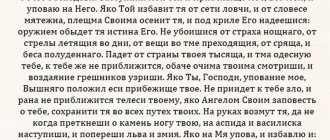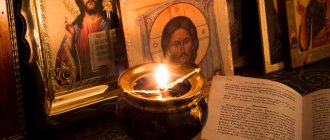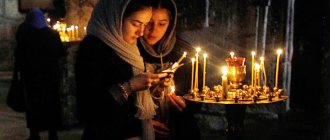Armenians were the first in the world to adopt Christianity as a state religion and are considered one of the most religious nations. The traditions of this people have much in common with Russian Orthodoxy, but at the same time they have certain differences. The cross of the Armenian Apostolic Church looks special, serving as an integral symbol of faith. Due to its unique and picturesque appearance, it is often called Blooming or Sprouted.
Read a prayer in Armenian online
It is not always possible to carry a prayer book with you. Even if it is a small collection, there are situations when there is nowhere to put it. To read prayer words, you can use a smartphone or PC with Internet access. The option of reading text online is not suitable for everyone; discomfort may arise on a regular basis (for example, the eyes get tired quickly), but as an exception this method is acceptable.
Հաւատամք ի մի երկնի եւ երկրի, երե ւելեաց եւ աներեւութից։
Եւ ի մի Տէր Յիսուս Քրիստոս, յՈրդին Աստուծոյ, ծնեալն յԱստուծոյ Հօրէ, cordial ած ճշմարիտ յԱստուծոյ ճշմարտէ, ծնունդ եւ ոչ արարած։
նոյն ինքն ի բնութենէ Հօր, որով ամենայն ինչ եղեւ յերկինս եւ bed A
Որ յրղագս մեր մարդկան, եւ վասն մերոյ փրկութեան իջեալ ի յերկնից՝ մար մնացաւ, մարդացաւ, ծնաւ կատարելապէս ի Մարիամայ սրբոյ կուսէն Հոգւովն Ս րբով։
Որով էառ մարմին, հոգի եւ միտ, եւ զամենայն որ ինչ է ի մարդ, ճշմարտապէս եւ ոչ կարծեօք։
Չbed: նօր։
cordial րոյ թագաւորութեանն ոչ գոյ վախճան։
?????? որ խօսեցաւ յօրէնս եւ ի մարգարէս եւ յԱւետարանս. որ էջն ի Յորդանան, քարոզեաց յառաքեալսն, եւ բնակեցաւ ի սուրբսն։
Ամէն:
Հաւատամք եւ ի մի Միայն, Ընդհանրական, եւ Առաքելական, [Սուրբ] Եկեղեցի. ի մի մկրտութիւն, յապաշխարութիւն, ի քաւութիւն եւ ի թողութիւն մեղաց. ի յարութւն մեռելոց ի դատաստանն յաւիտենից հոգւոց եւ մարմնոց. յարքայութիւնն երկնից, եւ ի կեանսն յաւիտենականսն։
Send this prayer to your loved ones
The formation of Christianity in Armenia
Before the adoption of Christianity, the people inhabiting the current territory of Armenia adhered to paganism. There is little information left about those times, because the Armenian alphabet was created only in the 5th century. Information was passed on by word of mouth, so many facts about pre-Christian times have come down to us distorted.
The faith of the Armenian people is considered the Chief Apostolic
After the adoption of Christianity, temples were built on the site of pagan temples, so actual evidence of the period of polytheism was also lost. The first people who brought the new faith to the territory of Armenia were the disciples of Christ - the apostles Thaddeus and Bartholomew. Apostle Thaddeus was executed along with his followers.
Similar articles:
- Greek Orthodox Church
- Holy Monasteries of Armenia
Apostle Bartholomew also suffered martyrdom by order of the Armenian king. But persecution could not stop the spread of Christianity. After the asceticism of the apostles, many believers appeared in Armenia. Christians prayed secretly; they did not have churches or other places of worship.
Later, the new religion gained wide popularity in neighboring countries with which Armenia was connected by trade, culture and a common past. This prepared good ground for the spread of Christianity in Armenia.
The situation changed in 314, when King Tiridates III was baptized and issued a decree on the construction of the first Christian temple. This year became the official date of the adoption of Christianity by the people of Armenia.
Interesting to know! The Etchmiadzin Cathedral, founded by Tiridates III, is still considered a religious center for all Armenians. This is the main seat of the Supreme Patriarch and Catholicos.
The break between the Armenian Church and Orthodoxy occurred in the 5th century due to the inaccurate translation of some decisions taken by the Ecumenical Council of Chalcedon.
In subsequent periods, the Armenian Church repeatedly sought common ground with Catholicism. In 1198, a union was signed between the Catholic and Armenian Apostolic Churches, but this led to a schism and the formation of the Armenian Catholic Church. As a result, the Apostolic Church remained a separate independent denomination.
Prayer Creed in Armenian (text in Russian letters with emphasis)
If you set a goal to become familiar with the culture of another country, you can start with prayer texts. First, you can take as a basis the version written in Russian letters. This will help you remember the spelling of words correctly. If you read texts with emphasis, you will also have the opportunity to become familiar with the pronunciation. Soon you will be able to pronounce prayer words without the help of a prayer book. Thanks to this, learning will be simplified, as some knowledge will appear.
Khashchatamk' and mi Astuats, and Khayrn amenakal, yararich'n yerkni yev yerkri, yereveleats' yev anerevut'its'։
Yev and mi Ter Yisus K'ristos, yOrdin Astutsoy, tsnealn yAstutsoy Hore, miatsin՝ aysink'n yyut'yene Khor։Astuats yAstutsoy, Loys and Lusoy, Astuats chshmarit yAstutsoy chshmarte, tsnund yev voch' araratson
noyn ink'n and bnut'yene Khor, vorov amenayn inch' yegkhev yerkins yev and vera yerkri, yerevelik' yev anerevoyt'k'։
Vor yaghags mer mardkan, yev vasn meroy p'rkut'yean ieal i yerknits'՝ marmnats'ashch, mardats'ashch, tsnasch katarelapes and Mariamay srboy kusen Hogschovn Srbov։
Vorov earr marmin, hogi yev mit, yev replacement vor inch' e and mard, chshmartapes yev voch' kartseok'։
Ch'arch'areal, khach'yeal, t'agheal, yerrord aschur yaruts'yel, yeleal and yerkins novin marmnovn, nstasch ynd aime Khor։
Galots' e novin marmnovn yev p'arrok' Chorus and datel zkendanis yev zmerreals, voroy t'agaschorut'yeyann voch' goy Vakhchan։
Khaschatamk'yev and Surb Hogin, Yaneghn yev and Katarealn. thief khosets'asch yorens yev and margares yev yashchyetarans. vor ein and Yordanan, k'arozeats' yarrak'yealsn, yev bnakets'ashch and surbsn։
Amen:
Khashchatamk'yev i mi Miayn, Yndkhanrakan, yev Arrak'yelakan, [Surb] Yekeghets'i. and mi mkrtut'ischn, yapashkharut'ischn, and k'aschut'ischn yev and t'voghut'ischn meghats'. and yarut'ishn merrelots'. and datastann yaschinits' hogschots' yev marmnots'. bright'ayut'ischnn yerknits', yev and keansn boxes onkansn։
Send this prayer to your loved ones
Church organization and hierarchy
The highest level of the church hierarchical ladder in Armenia is occupied by the Catholicos. He has the same centralized power as the Pope in Catholicism. In Orthodoxy, Patriarch is an honorary title that does not grant its bearer special powers.
The highest ecclesiastical rank after Catholicos is bishop. Bishops are at the head of dioceses and are required to take monastic vows and have an academic degree.
The main link in church life are priests. They are responsible for the spiritual education of believers, the implementation of the Sacraments and the performance of divine services. Deacons and readers assist the priests.
Download the Creed prayer in Armenian from your phone memory and print it out
Carrying a small piece of paper with you is more convenient than a prayer book. Text that is important for the inner state of the soul can be downloaded and saved in the memory of your smartphone. When it is possible or necessary, it is printed. Moreover, this function is available for phones of different platforms: Android and iOS.
Send this prayer to your loved ones
Send this prayer to your loved ones
Symbol meaning
The Armenian cross symbolizes life, development, spiritual prosperity. That is why it is customary to decorate it with intricate patterns and floral ornaments, which speak of great life-giving power. “Swallow tails,” by the presence of which the Sprouted Cross can be easily distinguished from other religious symbols, imply eternal existence and remind believers of the immortality of the soul.
Christians living in Armenia claim: the cross is a bright symbol and should not carry reminders of death and torment. It testifies to the greatest gift of the Lord to all people - the opportunity to save your soul and come to endless life in the Kingdom of Heaven.
Latin transcription of the prayer
When a foreign text is written in Russian letters, it is not always possible to accurately convey the features of the pronunciation of words. It is recommended to additionally read the Latin version (in the form of transcription). This method makes it easier to understand unfamiliar words. It will be easier to remember them in the future. It is recommended to move on to the Latin transcription after the version written in Russian letters has been studied.
| In Russian | Latin transcription |
| Khashchatamk' and mi Astuats, and Khayrn amenakal, yararich'n yerkni yev yerkri, yereveleats' yev anerevut'its'։ Yev and mi Ter Yisus K'ristos, yOrdin Astutsoy, tsnealn yAstutsoy Hore, miatsin՝ aysink'n yyut'yene Khor։Astuats yAstutsoy, Loys and Lusoy, Astuats chshmarit yAstutsoy chshmarte, tsnund yev voch' araratson noyn ink'n and bnut'yene Khor, vorov amenayn inch' yegkhev yerkins yev and vera yerkri, yerevelik' yev anerevoyt'k'։ Vor yaghags mer mardkan, yev vasn meroy p'rkut'yean ieal i yerknits'՝ marmnats'ashch, mardats'ashch, tsnasch katarelapes and Mariamay srboy kusen Hogschovn Srbov։ Vorov earr marmin, hogi yev mit, yev replacement vor inche' e and mard, chshmartapes yev voch' kartseok'։ Ch'arch'areal, khach'yeal, t'agheal, yerrord aschur yaruts'yel, yeleal and yerkins novin marmnovn, nstasch ynd aime Khor։ Galots' e novin marmnovn yev p'arrok' Choir and datel zkendanis yev zmerreals, voroy t'agaschorut'yeyann voch' goy Vakhchan։ Khaschatamk'yev and Surb Hogin, Yaneghn yev and Katarealn. thief khosets'asch yorens yev and margares yev yashchyetarans. vor ein and Yordanan, k'arozeats' yarrak'yealsn, yev bnakets'ashch and surbsn։ Amen: Khashchatamk' yev i mi Miayn, Yndkhanrakan, yev Arrak'yelakan, [Surb] Yekeghets'i. and mi mkrtut'ischn, yapashkharut'ischn, and k'aschut'ischn yev and t'voghut'ischn meghats'. and yarut'ishn merrelots'. and datastann yaschinits' hogschots' yev marmnots'. bright'ayut'ischnn yerknits', yev and keansn boxes onkansn։ | Hawatamk' i mi Astuats, i Hayrn amenakal,yararich'n yerkni yev yerkri, yereveleats' yev anerevut'its'։ Yev i mi Ter Yisus K'ristos, yOrdin Astutsoy, tsnealn yAstutsoy Hore, miatsin՝ aysink'n yeut'yene Hor։Astuats yAstutsoy, Loys i Lusoy, Astuats chshmarit yAstutsoy chshmarte, tsnund yev voch' ararats։ noyn ink'n i bnut'yene Hor, vorov amenayn inch' yeghev yerkins yev i veray yerkri,yerevelik' yev anerevoyt'k'։ Vor yaghags mer mardkan, yev vasn meroy p'rkut'yean ijeal i yerknits'՝ marmnats'aw, mardats'aw, tsnaw katarelapes i Mariamay srboy kusen Hogwovn Srbov։ Vorov earr marmin, hogi yev mit, yev zamenayn vor inch' ei mard, chshmartapes yev voch' kartseok'։ Ch'arch'areal, khach'yeal, t'agheal, yerrord awur yaruts'yeal, yeleal i yerkins novin marmnovn, nstaw ynd ajme Hor։ Galots' e novin marmnovn yev p'arrok' Hor i datel zkendanis yev zmerreals, voroy t'agaworut'yeann voch' goy vakhchan։ Hawatamk' yev i Surb Hogin, yaneghn yev i katarealn. vor khosets'aw yorens yev i margares yev yAwyetarans. vor ejn i Yordanan, k'arozeats' yarrak'yealsn, yev bnakets'aw i surbsn։ Amen: Hawatamk' yev i mi Miayn, Yndhanrakan, yev Arrak'yelakan, Yekeghets'i. i mi mkrtut'iwn, yapashkharut'iwn, i k'awut'iwn yev i t'voghut'iwn meghats'. i yarut'iwn merrelots'. i datastann yawitenits' hogwots' yev marmnots'. yark'ayut'iwnn yerknits', yev i keansn yawitenakansn։ |
Sacraments of the Armenian Apostolic Church
- Baptism is the very first Sacrament. Without accepting it, a person cannot participate in others. During the Sacrament of Baptism, children are dipped into consecrated water three times, adults have their faces washed or water is poured on their heads. Simultaneously with baptism, the Sacrament of Confirmation and Communion is performed.
In an Armenian church, the altar is not fenced off with icons - In the Armenian Church, confirmation takes place immediately after baptism. It symbolizes the grace of the Holy Spirit and is performed to strengthen one’s faith. The anointing with myrrh is accompanied by appropriate prayers.
- Repentance consists of admitting one's sins. A repentant Christian confesses to the Lord and strives to correct his life. Confession is accompanied by a special prayer and is preceded by several days of fasting.
- When taking communion, believers eat bread and wine as a sign of unity with the Lord and desire for Eternal Life. Before communion, one is required to fast and confess.
- Through ordination and chrism, the priest receives the grace of the Holy Spirit and the right to transmit it to others.
- Marriage is the union of the soul and flesh of husband and wife into a single whole. A loving couple can get married if the boy is 18 years old and the girl is 16. Marriages of convenience and coercion are not recognized by the Church.
- The Sacrament of Anointing is performed in relation to seriously ill patients, in the hope of their recovery or deliverance from severe torment.
Reading rules
When prayer words are spoken, it is necessary to put your soul into them. Only with a sincere appeal can you ask for help and support during trials. God hears prayers in any language, but it is important not just to pronounce the words, but to understand their meaning. Moreover, knowledge should come not from the head, but from the heart.
It is necessary to perform all the basic rituals and actions that accompany the reading of the prayer text. For example, special attention is paid to the sign of the cross and bow. These steps should not be performed in haste. It is recommended to turn to the Lord before the image; a candle is also lit.
God is within us, so failure to follow the rules is not a sin,
but they allow you to get closer to the Divine, strengthen your aspiration towards the Almighty, and strengthen your faith.
The prayer is said under certain conditions. It helps to understand the basics of religion. As a result, the knowledge of a believer deepens. Today, baptism is often performed in infancy. At this age, a new person cannot yet understand the basics of Christianity, but the prayer text is read by the godparents. They must know the words by heart.
Avatamk
The Creed is a briefly and accurately described object of Christian faith. The AAC uses 3 ancient Creeds.
Apostolic Symbol (I), read during the Sacrament of Baptism:
The : cords cordial ումն, զնստիլն ընդ աջմէ Հօր, զահաւոր եւ զփառաւորեալ զմիւսանգամ Գալուս տնւ հաւատամք:
havatamk ħAmenasurb Errorudutyunen, and hair ev ħOrdi ev and Surb hogi. Zavetumen Gabrieli, ezTsnunden Christosi, ezMekertutyunen, ezCharcharanes, ezKhachelutyunen, ezTahumn erekorya, ezharutyunen, zastvatsapes hambartsumen, eznestiln and ajme hor, zahavor ev ezparavoryal ezmyusangam Galusten - hostanimk ev havat amk.
We believe in the Holy Trinity, the Father and the Son and the Holy Spirit. The Gospel of Gabriel, the Nativity of Christ, Baptism, Passion, the Crucifixion, the three-day burial, the Resurrection, the divine Ascension, sitting at the right hand of the Father, the terrible and glorious next Coming - we confess and believe.
The Armenian Church accepts the Orthodox Creed, approved at the First Ecumenical Council in 325 in the Byzantine city of Nicaea - the Nicene Creed. At the Liturgy of the Apostolic Church, an expanded version of the Nicene Symbol is read, which is a kind of analogue of the Byzantine so-called. “Nikeo-Constantinople” Symbol, but is not identical to it. Let us note that a person who does not accept all the provisions of the Creed cannot be a child of the Church, and in general a Christian.
The Amplified Nicene Creed (II) has a very logical structure:
“We believe in one God, the Father Almighty, Creator of heaven and earth, visible and invisible. And in one Lord Jesus Christ, the Son of God, born of God the Father, the only begotten, precisely from the nature of the Father. Into God from God, into Light from Light, into true God from true God, begotten and not made; Consubstantial with the Father, by Whom all things were created in heaven and on earth, visible and invisible. For the sake of us people and for the sake of our salvation, He came down from heaven, became incarnate, became human, completely born of the holy Virgin Mary by the Holy Spirit. From her he received flesh, soul, mind and everything that is in a person - true, and undoubtedly. He suffered, was crucified, was buried, was resurrected on the third day, ascended into heaven in the same body, and sat down at the right hand of the Father. He who comes in the same body and in the glory of the Father will judge the living and the dead; His Kingdom has no end. We also believe in the Holy Spirit, uncreated and perfect, who spoke in the Law, Prophets and Gospels. He who descended on the Jordan, preached through the apostles and dwelt among the saints. We also believe in one Catholic Apostolic Holy Church. In one baptism, in repentance, cleansing and remission of sins; In the resurrection of the dead; to judgment forever upon souls and bodies*; To the kingdom of heaven and to eternal life."
* - We draw your attention to the fact that the words “in judgment forever, souls and bodies” mean that it is not the trial itself that will last forever, but the decision made at the judgment of God will be eternal and unchangeable, like any word of God.
Audio version of the Creed.
(III) The Creed of Saint Gregory of Tatevatsi was compiled to refute the slander against the Armenian Church, as if the Armenians adhere to the Monophysite heresy:
“We confess and believe with all our hearts in God the Father - Uncreated, Unbegotten, and Without Beginning; and also the Parent of the Son and the Originator of the Holy Spirit.
We believe in God the Word - Uncreated, Begotten, and Begun from the Father (Having a beginning from the Father) before the eternities - not after and not less (the Father); and how much the Father is the Father, and with Him the Son is the Son.
We believe in God the Holy Spirit - Uncreated, Timeless, Unbegotten, and Coming from the Father; Consubstantial with the Father and of the same Glory as the Son.
We believe in the Holy Trinity - One Nature, One Divinity, not Three Gods, but One God, One Will, One Kingdom, One Power; Creator of the visible and invisible.
We believe in the Holy Church; for the remission of sins, the communion of Saints.
We believe in One of the Three Persons, in God the Word - Born of the Father before the eternities; in time, descended into the Mother of God the Virgin Mary, took from Her blood and united it to His Divinity; endured 9 months in the womb of the Immaculate Virgin.
And the Perfect God became the Perfect Man - with soul, spirit and body; One Person, One Person, and One United Nature.
God made man without change or distortion; conception without seed and incorruptible birth; for there is no beginning to His Divinity, and there is no end to His Humanity: “Jesus Christ is the same yesterday and today and forever.”
We believe in our Lord Jesus Christ - Who walked the earth; came to baptism after 30 years.
The Father, who testified from above: “This is My Beloved Son”; and the Holy Spirit descended upon Him like a dove.
Tempted by Satan and victorious over him. Preaching salvation to people. Labored in the flesh, tired, hungry, and thirsty. Afterwards, who voluntarily came to suffering; crucified and died in the flesh, and lives in the Divinity.
The body laid in a coffin united with the Deity; and soul descended into hell, undivided with the Divine. Preached to souls, destroyed hell, and set souls free. After three days he rose from the dead and presented himself to the disciples.
We believe in our Lord Jesus Christ, who ascended into heaven in the same body and sat down at the right hand of the Father. And also, he will appear with the same body in the Glory of the Father, to judge the living and the dead, during the resurrection of all people. We believe in the reward of works—eternal life for the righteous, eternal torment for sinners.”
Dioceses of the Armenian Apostolic Church
The Armenian diaspora in the world is considered numerous. In places of permanent residence, believers strive to found a temple in order to gather there for prayer and during holidays.
Dioceses of the Armenian Apostolic Church are located on all continents, their number in other countries depends on the number of believers. Thus, in Africa the Apostolic Church is represented by only one diocese, but in Europe there are more than 10 of them. In Russia there are the New Nakhichevan and Southern Russia Dioceses.
Armenian Apostolic Church of the Holy Cross Surb Khach in Samara
The most numerous dioceses are:
- Ararat;
- Armavir;
- Georgian;
- Ukrainian;
- Greek;
- Gugarkskaya;
- Swedish.











